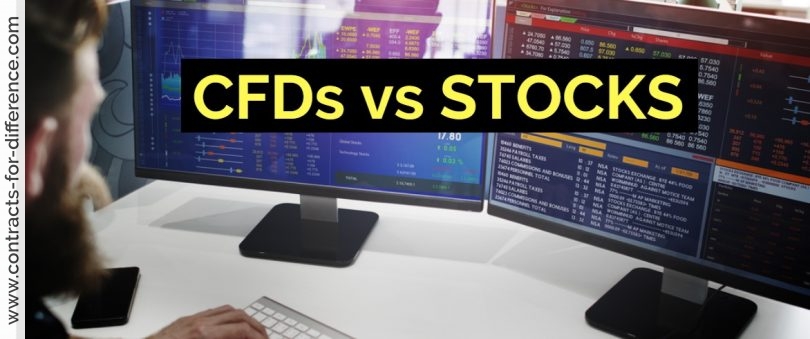Q:What is the difference between buying a share through a traditional broker versus trading it via a contract for difference?
A: CFD trading is very similar to shares trading except that when you trade a contract for difference you don’t own the underlying share. Unlike investing in stocks, when you trade CFDs, you are not buying or trading the underlying asset. What you are buying is a contract between yourself and the CFD provider.The key difference between trading a CFD long and buying a security is due to the leverage that is employed. Contracts for difference are traded on margin which means that there is no need to tie up the full market value of purchasing the equivalent stock position. This also allows traders to open larger positions than their capital would otherwise allow.
There are a number of key differences between trading an underlying asset and a CFD -:
- As opposed to holding the underlying asset, a CFD is traded on margin which means that an initial deposit is lodged with the CFD broker which allows the investor to buy or sell a number of CFDs according to margin computations which allow extra leverage over the stock purchase itself.
- The investor doesn’t down own the underlying asset over which the CFD is based but enters a contractual agreement with the CFD broker to exchange the cash difference in price between the opening and closing prices of the contract.
- CFDs can be traded short or long and you are not required to deliver the underlying asset in the event of a short sale.
- Presently, CFDs are exempt from UK stamp duty of 0.5% although profits are subject to capital gains tax.
One CFD will usually be equivalent to one share, except that with a contracts for difference position your provider will usually only require you to put down 5% to 20% of the actual contract value in order to trade. On a share CFD with a 5% margin, you can gain exposure up to twenty times as many shares for the same capital outlay compared to an investor in physical shares. For instance, suppose you buy 5 shares of Google at $400, you would have to pay $2000 ($400 x 5). But if you bought 5 Google CFDs at $400, and the margin requirement was 10%, you would only be required to fork out $200 leaving you money to use on more trades. The net effect is a return (or loss) of 10+ times the amount using CFDs over shares due to the leverage that is employed. The fact that CFDs are traded on margin (which means that your broker is effectively lending you money) implies that a contracts for difference trade attracts finance charges while a position is held, while this does not apply to the share trade. The interest is charged on the full market value of the CFD position and the rate is set by your CFD provider, and again usually set with a spread around the base rate of the country within which the stocks are traded. So for shares traded on the London Stock Exchange, this would be LIBOR while for USA shares this would be the Fed Rate..etc.
The downside is that geared trading opens you up to the risk of losing more than your initial outlay – there is a risk that you would wipe out your account and end up owing more funds to your CFD provider. This cannot happen if you buy the physical shares. This could happen, for instance if you were to short shares and the market moved sharply against you. Of course, it is very difficult for retail investors to short shares in the physical market. It is also important to note that while the value of the CFD is derived from the value of the underlying asset, it may not mirror it exactly.
Lastly, and this is an important difference with CFDs you do you have the right to acquire the referenced shares, or benefit from any ownership rights, such as voting rights, in the underlying shares and therefore only have an economic interest in the share. So for instance if you trade a CFD on Apple or BP, you are in effect trading the price difference between your entry point and your exit point. You do not own the Apple or BP shares, you are only speculating on their price going up or down. CFDs are concerned ONLY with movements in price – nothing else. The contract is between you and your broker.
CFDs provide all the benefits of share trading combined with the added advantage of being able to utilise your unrealised profit, and only outlay part of the full notional value of your position.
Q:Do I get a share certificate when I trade a share CFD?
A: No, you’re not actually buying stock in that company, you are only trying to capture the price movement between the time you open a CFD trade until the time you close it.Q:Do CFDs have the 3 days settlement period like real shares?
A: No, CFDs don’t have the 3 day settlement like real shares. Settlement is done as soon as you press buy/sell.Q:Why trade CFDs instead of stocks?
A: For several reasons -:- Gearing i.e. the ability to leverage your capital. You are only required to provide only initial collateral at between 5 to 10% of the nominal value of the underlying share when the contract is opened. This allows you to trade up to 20 times (sometimes even more!) the value of your cash outlay – potentially benefiting from stock price movements without having to purchase that share outright. If you have $20,000 in a shares dealing account, then you would be able to buy shares for a total market value of $20,000. Once all your capital is ‘invested’ in positions you wouldn’t be able to take advantage of other trading opportunities unless you sold a portion of your stock portfolo. This is not so with a CFD brokerage account where if you put $20,000 in it – not only would you still be able to trade up to $20,000 but more importantly you will also be able to open extra positions should you notice other trading opportunities (without having to sell any of your existing holdings). This is leverage and is the greatest advantage of CFDs compared to traditional shares dealing.
- Ability to go short which allows you to take advantage of an overvalued stock – if you consider a share overvalued, you can short the stock using a CFD to benefit from a fall in its share price (with no extra costs).
- Avoidance of stamp duty in the UK and Ireland. In quite a few cases the half-percent saving from the stamp duty exemption will actually exceed the round trip commission costs for opening and closing the trade.
- Direct trading on live tradable prices – CFDs mirror the price of the underlying instrument and there’s no waiting for the execution of orders. Using DMA CFDs, every trade has a corresponding trade in the real market, so you are able to take part in the opening and closing price auctions.
- CFDs allow you to make use of more advanced strategies and tactics such as hedging your existing share portfolio.
- Dividends – When holding a long CFD position over the ex-dividend date, you will receive the dividend into your trading account immediately (usually on that same day).
- Minimum amount to start trading CFDs is usually $5,000 or less.
- Many international markets accessible from one CFD account – be it shares, forex pairs, indices, commodities, sectors..etc. This is another big advantage of utilising CFDs versus a traditional stock broker.
However, it is well worth noting -:
- CFDs are not standardised and every CFD provider has their own terms and conditions.
- Leverage means small market movements can have a big impact on the success of your trades..
- With CFDs the issue of counterparty risk crops up. Incidentally, since all you own is a contract with the CFD provider, you are also relying that the CFD provider is in a sound financial position and will be able to meet their obligations to you so it is wise to find a well-capitalised regulated provider.
In addition the evolution of the Internet and electronic trading platforms has reduced transaction costs involved in undertaking CFD transactions.
Most CFD traders want good leverage – paying small margins for potentially big pay outs. However it is important to have realistic margins. Too high and it’s not worth it, but too low and you just have too much rope to hang yourself by…
Q:If the CFD price moves like the stock price, why would you trade a CFD on IBM instead of just trading the IBM stock itself?
A: CFDs allow you to trade on margin (you don’t need to pay 100% upfront and in most cases allow you to control much bigger positions with a fraction) and in the UK you don’t even pay stamp duty with CFDs. CFDs replicate all the financial benefits of share ownership bar voting rights. Dividends and rights issues are replicated by crediting the account as if each CFD were an actual share. For example, if one owned a CFD on Marks and Spencer you would receive any profit or loss from the movements in the actual share price. However you would also receive any dividend payments from Marks and Spencer that you would have received had you owned the actual stock instead.To see the effect of gearing, here is an example of a CFD trade compared to a traditional equity trade, where the investor uses the same amount required for a CFD deposit to buy ordinary shares instead.
| Opening the Position | ||||
| CFD Deal | Equity Deal | |||
| Price of Company Z | 112p | 112p | ||
| Number of Shares | 20,000 | 2,000 | ||
| Value of Shares | £22,400 | £2,240 | ||
| Commission | £33.60 | £17.50 | ||
| Stamp Duty | £0 | £11.20 | ||
| Total Value of Transaction | £22,433.60 | £2,268.70 | ||
| Deposit Required | £2,240 | £0 | ||
| Initial Cost | £2,273.60 | £2,268.70 | ||
| Closing the Position | ||||
| CFD Deal | Equity Deal | |||
| Price of Company Z | 115p | 115p | ||
| Number of Shares | 20,000 | 2,000 | ||
| Value of Shares | £23,000 | £2,300 | ||
| Commission | £34.50 | £17.50 | ||
| Difference in share value | £600 | £60 | ||
| Financing (3 days) | £9.67 | £0 | ||
| Profit (difference – commission charges) | £522.23 | £13.80 | ||
| Percentage ROI | 23.32% | 0.61% | ||
As you can see for the same initial outlay you can control a much larger position with a contract for difference as the contract is traded on margin. This means that you can substantially increase the return on your investment – but you should note that any losses would be equally multiplied.
The main challenge is still in educating people about CFDs versus physical trading and spreadbetting and how to use leverage in a profitable way. I firmly believe that serious traders should use CFDs in terms of cost, execution and versatility. There is no stamp duty, no extra spread (so costs are transparent), no expiry period and you can go long or short and gain leverage easily. The challenge is to use these products correctly; limiting your downside, positioning yourself sensibly in the market and avoiding taking profits too early.


Leave a Comment